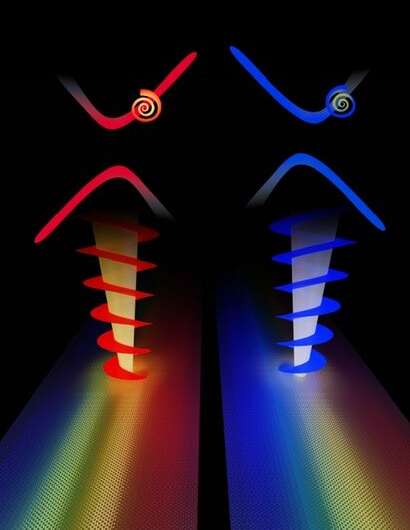Researchers use structured light on a chip in another photonics breakthrough

In everyday life we experience light in one of its simplest forms鈥攐ptical rays or beams. However, light can exist in much more exotic forms. Thus, even beams can be shaped to take the form of spirals; so-called vortex beams, endowed with unusual properties. Such beams can make dust particles to spin, just like they indeed move along some intangible spirals.
Light modes with such added structure are called "structured," and even more exotic forms of structured light can be attained in artificial optical materials鈥攎etamaterials, where multiple light waves come together and combine to create the most complex forms of light.
In their two recent works, published back-to-back in Science Advances, and Nature 糖心视频, City College of New York researchers from Alexander Khanikaev's group have created structured light on a silicon chip, and used this added structure to attain new functionalities and control not available before.
To this aim, two-dimensional optical metamaterials, referred to as metasurfaces, and hosting a special kind of structured light spinning around just like vortex beams were created. By experiments carried out in Khanikaev's laboratory at The City College, researchers demonstrated a new kind of trap to confine structured optical modes and to guide them on the chip.
In their Science Advances work, researchers show that, by slowly changing the pattern of metasurface in two directions, one can create optical resonators which trap structured light and radiate it. Interestingly, this underlying structure gave rise to unusual patterns of the radiated light鈥攐ptical vortex beams.
Applying similar slow change in the pattern in one direction, as reported in Nature 糖心视频 work, researchers have created waveguided for structured light. These channels allow guiding optical signals while preserving the internal structure of light. As such, this is similar to the flow of currents in wires, if we could have wires with two flavors of charges.
Interestingly, such currents have been of enormous interest in electronics recently, and a completely new class of electronic devices, commonly referred to as spintronic or valleytronic, was envisioned. In such devices it is not the flow of charge by itself that would transfer signals, but spin or valley of electrons, which promises a plethora of advantages in comparison to conventional electronic devices.
Khanikaev's work envisions a similar concept, but with light rather than electrons. However, in contrast to electronic systems, optics and photonics have one significant advantage鈥攐ptical modes do not suffer from decoherence to the same degree as electrons, which can be vital for quantum technologies.
The demonstrations by Khanikaev's group can be useful for quantum applications for several reasons. Thus, the added structure of optical modes can be used to encode quantum information in the form of quantum bits. This information can then be transported on a chip or emitted into free space for communicating quantum information between remote systems.
Moving in this direction, the Khanikaev group is currently working on implementing these ideas with quantum states of structured light and realizing quantum logic in their photonic nanostructures.
More information: Svetlana Kiriushechkina et al, Spin-dependent properties of optical modes guided by adiabatic trapping potentials in photonic Dirac metasurfaces, Nature 糖心视频 (2023).
Kai Chen et al, Photonic Dirac cavities with spatially varying mass term, Science Advances (2023).
Journal information: Nature 糖心视频 , Science Advances
Provided by City College of New York




















